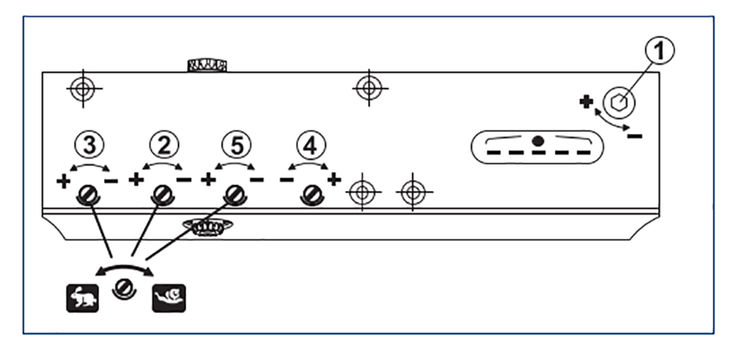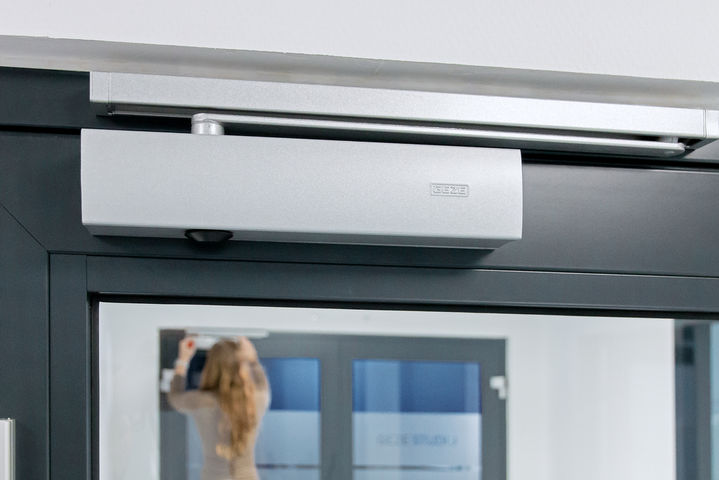Correctly setting GEZE door closers - what you need to know!
From fire protection to accessibility and comfort - door closers need to fulfil a wide range of requirements. To reliably, securely and continuously perform all of these functions, professional installation, setting and maintenance of the door closer is essential. Here, installation engineers can learn what to keep in mind during professional installation - and what parameters must be met in order to ensure access convenience as well as safety.
Key parameters for door closers at a glance

1. Door closer size/closing force 2. Closing speed 3. Latching action (TS 5000/ TS 4000S) / latching action speed (TS 5000 SoftClose) 4. Back check 5. Delayed action (TS 4000 S/TS 5000 S) 6. Closing force display © GEZE GmbH
The basic functions of a door closer that can be adjusted individually are:
- Closing force or door closer size,
- Closing speed,
- Latching action,
- Back check and
- Closing delay.
Please note that door closers must always be installed and adjusted by professional technicians. Please call a qualified technician for door closers on fire protection, rescue and escape route doors, in particular, since professionally installed door solutions can save human lives in case of a fire. We will accept no liability for improper installation and setting. Likewise, the adjustment screws should be used only with great care and with the right tools
Individual setting options
Setting variants differ between different models. We recommend reviewing the official recommended settings for GEZE door closers.
Download installation options for overhead door closers (PDF | 3.10 MB)The closing force is the force that the door closer exercises on the door leaf in order to close the door. The closing force (also known as the door closer size) is determined based on the leaf width of the door to be closed. This means that the first step is to determine the leaf width, which requires a certain closing force of the door closer in accordance with DIN EN 1154. In addition, other structural circumstances can require setting a higher size. These include, for example, the door height, door width or on-site circumstances like the influence of wind.
The closing force of a door closer is described by its EN class. Class EN 1 applies to doors with a narrow door width or leaf width and low weight, such as doors inside a residential building. Generally, a larger door closer size is required for a front door. A minimum closer size of EN 3 is required for fire protection doors. Closers on smoke and fire protection doors are permitted up to a maximum of 1600 mm (EN 7) door leaf width.
The closing force is regulated via an individual adjustment screw on the closer. You can read the applicable EN value on the closing force display.
The closing speed regulates the speed with which the door closer closes a door.
The closing speed may not be set too high, to ensure the door does not shut in the face of the next person going through it. Likewise, it may not be set too low, so as to ensure that the door closes securely. Therefore, adjust it so that the door closes within 5-7 seconds from a 90° open position. In particular in buildings like multi-family houses or office buildings, doors that are standing open may pose a safety risk as they allow unauthorised persons to access the area. In many cases, closed doors also help save energy.
You can use the so-called latching action to adjust how quickly the door falls into the lock. This means that the door movement is accelerated in the last few degrees before it closes in order to overcome any closing resistance such as friction resulting from door seals. This ensures that the door falls securely into the lock.
If the latching action is too strong, the door will close with a slam. If the regulation is too weak, on the other hand, the door may not be able to close fully on its own.
The back check is a shock absorber that prevents a door from being opened too forcefully. Persons, door elements, adjacent walls or objects behind the door are protected.
So the back check reduces the speed of a door that has been opened forcefully. However, for instance in doors that open outward and may be exposed to the wind, it must not be used as a substitute for separate measures designed to limit the opening angle - such as installing a door stopper or other structural methods. Note: the valve should not be opened too far, since this can cause leaks.
The delayed closing reduces the closing speed of a door. This gives persons with luggage, walking aids, and other restrictions enough time to pass through the door.
Find the door closer to meet your needs
Our portfolio offers a wide selection of door closers that are suitable for different installation situations, and that offer multiple custom setting options. The GEZE door closer line ranges from overhead door closers to many different variants for fire and smoke protection doors.
To make it easier for you to choose the right door closer, we provide a convenient product finder that systematically asks about all stipulations and functions. This helps you navigate quickly and easily to the product that meets your needs.
The GEZE TS 5000 SoftClose

© GEZE GmbH
Some room conditions make it more difficult for the door to close securely and silently. Because of this, we have expanded our portfolio and launched a new variant, the TS 5000 SoftClose, in addition to our proven TS 5000 door closer. Our door technology product manager, Alexander Müller, explains the advantages of the TS 5000 SoftClose in an interview, along with its unique features for installation engineers and operators.
Installation videos for GEZE door closers
We provide a series of installation videos on our YouTube channel to help you as an installation engineer with installing and setting GEZE products. Here, you can find videos on GEZE door closers. All models are installed based on the same template.
To the GEZE YouTube channelFrequently asked questions about setting GEZE door closers
Sometimes, door closers do not work as they are expected to - whether due to improper handling or environmental influences. It is possible that door closers may need to be readjusted due to temperature fluctuations.
The following is a list of the most common causes of problems, and possible ways to correct them.
Please note: We will accept no liability in case of improper installation and setting. GEZE recommends having installation carried out by a professional technician if possible. Please call a qualified technician for door closers on fire protection, rescue and escape route doors in particular. In our trainings for installation engineers, you can gain an overview of the entire range of GEZE door closers, including installation and setting recommendations. Of course, we are also happy to assist you at any time!
| CAUSE | REMEDY |
| Closing process obstructed (doors dragging, seals jamming) | Remove the obstacle |
| Closing force adjustment (1) too low | Increase the closing force setting (1) (door closer size) |
| Draught | Check surrounding area and eliminate external influences (e.g. window, ventilation system) |
| Mechanical hold-open unit latched in | Pull closed until hold-open unit is released |
| CAUSE | REMEDY |
| Closing process obstructed (doors dragging, seals jamming) | Remove the obstacle |
| Closing force adjustment (1) too low | Increase the closing force setting (1) (door closer size) |
| Draught | Check surrounding area and eliminate external influences (e.g. window, ventilation system) |
| Closing speed (2) too low | Increase closing speed (2) |
| CAUSE | REMEDY |
| Closing speed (2) too high | Reduce speed (2) |
| Latching action or latching action speed (3) too strong/fast | Reduce latching action or latching action speed (3) |
| Door closer is losing oil | Replace door closer |
| Draught | Check surrounding area and eliminate external influences (e.g. window, ventilation system) |
| CAUSE | REMEDY |
| Closing force (1), latching action or latching action speed (3) set too low | Increase closing force (1), latching action or latching action speed (3) |
| Lock latch sluggish | Check, lubricate (note manufacturer's instructions!) |
| CAUSE | REMEDY |
| Sluggish doors/hinges (doors dragging, seals jamming) | Remove obstacle/set hinges |
| Incorrect closer size (1) | Reduce closing force (1) (note minimum closing force on fire protection doors!) |
| Draught | Check surrounding area and eliminate external influences (e.g. window, ventilation system) |
| CAUSE | REMEDY |
| Latching action or latching action speed (3) set too strong/fast | Check and adjust |
| CAUSE | REMEDY |
| Back check (4) set too strong | Check and adjust |
| CAUSE | REMEDY |
| Not activated/hold-open angle not reached | Check and set, open doors beyond the hold-open angle |
| CAUSE | REMEDY |
| Valve screws/adjustment screw over-tightened/damaged | Replace door closer |
Use our brochures and instructions for the door closer
Installation options for overhead door closers (PDF | 3.10 MB)
FAQs for the GEZE door closer (PDF | 603 KB)
Product brochure door closers with guide rail (PDF | 13.70 MB)
Product brochure overhead door closers with link arm (PDF | 6.77 MB)





